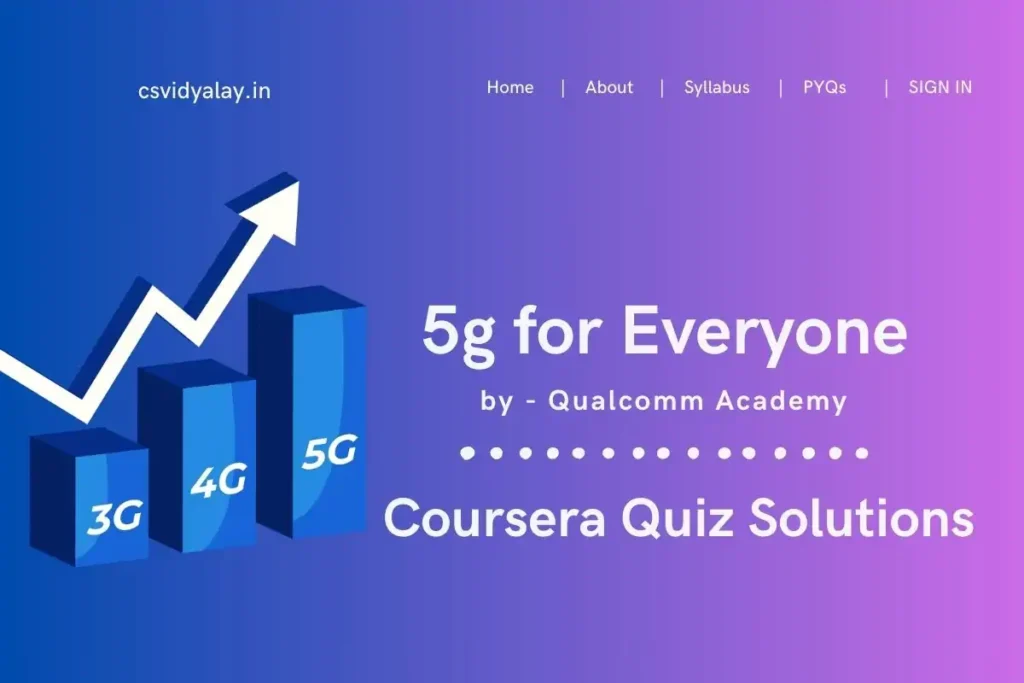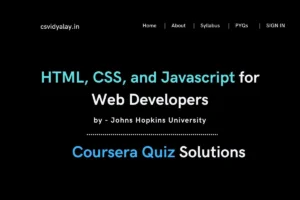Struggling with the Coursera 5G for Everyone quiz? Our post offers comprehensive solutions for the course, helping you understand 5G concepts and prepare for the challenges. We’ll guide you through the exciting world of 5G technology!
Unlock the power of 5G for Everyone! This course will guide you through the exciting world of 5G technology, showing you how it’s transforming the way we work and live. Discover how 5G is revolutionizing businesses, and how it can help yours thrive in today’s ever-changing environment. No prior tech knowledge is required – jump in and get started!

There are eight modules in the course “5g for Everyone”:
- Wireless and Cellular Communications Overview
- What is 5G and Why Do We Need It?
- 5G Network and Features
- 5G Spectrum and mmWave
- Massive MIMO
- 5G Radio Access Network (RAN)
- 5G Private Networks and Industrial IoT
- 5G Security
Contents
Week 1 – 5g for Everyone
Week 1 Quiz – 5g for Everyone
1. Frequency is measured in ______(1) and wavelength in _____ (2)
- Hz; meters
- meters; Hz
- watts; meters
- meters; ohms
2. The transmitter ______(1) and the receiver _____ (2).
- modulates; encodes
- demodulates; decodes
- demodulates; modulates
- modulates; demodulates
3. How does information travel in wireless transmissions?
- carrier waves
- SNR
- guard band
- power amplifiers
4. Which of the following factors can directly introduce errors in wireless transmission? (select all that apply)
- Wind
- Vehicular traffic
- Interference
- Electronic/ thermal noise
5. Which range of frequencies is allocated to mobile phones?
- 400 MHz to 50 GHz
- 100 MHz to 75 GHz
- 300 kHz to 10 GHz
- 450 MHz to 39 GHz
6. What is true about channel bandwidth? (select all that apply)
- It determines the data capacity of a wireless channel
- It is measured in meters
- It can be carefully shared among multiple users
- It is a measurement of cell size
7. ____(1) requires a pair of channels, whereas _____ (2) works by using a single channel in different directions at different times.
- QAM; FDD
- FDD; TDD
- SNR; TDD
- TDD; FDD
8. Which of the following can directly affect your data rate? (select all that apply)
- Network load
- Signal to Noise ratio
- Spectral efficiency
- Channel capacity
9. In a cellular network, a phone is served by the same tower no matter where it is located.
- True
- False
10. Which of the following are objectives of cellular network design? (select all that apply)
- B: Minimize data rate
- C: Maximize coverage area
- A: Minimize dropped calls
- D: Limit the number of base stations
Week 2 – 5g for Everyone
Week 2 Quiz – 5g for Everyone
1. What was the motivation for changing from analog to digitized voice in the 1990s for cellular communication? (select all that apply)
- Digitized voice offers better quality
- Analog voice is more compact but slower
- Digitized voice is more compact but slower
- Digitized voice is more compact and more efficient
2. Which generation of cellular technologies transformed the use of the cell phone and allowed it to be used for both voice and high-speed internet use?
- 3G
- 2G
- 4G
- 1G
3. Which are the three main service classes offered by 5G? (select all that apply)
- PDT
- Enhanced mobile broadband (eMBB)
- Ultra-reliable low-latency communications (URLLC)
- M-IoT/ massive machine type communication (mMTC)
4. What are some modern use cases that necessitate 5G? (select all that apply)
- Increasing demand for voice calls
- Connected vehicles
- Augmented reality
- High speed mobility
- Browsing the internet
5. Which of the following is true about eMBB?
- eMBB emphasizes maximizing speed
- Extremely low latency is the most important feature in eMBB services
- eMBB focuses most on very stringent reliability
- eMBB emphasizes maximizing battery life rather than speed
6. Which of the following values best describe eMBB in 5G?
- Peak user data rate <5 Gbps; peak network throughput >10 Gbps
- Peak user data rate ~500 Mbps; peak network throughput <1 Gbps
- Peak user data rate of 100 Mbps; peak network throughput <1 Gbps
- Peak user data rate >10 Gbps; peak network throughput >1 Tbps
7. Which service class emphasizes power conservation?
- eMBB
- URLLC
- mMTC
- C-V2X
8. Which of these are some of the basic features of mMTC/ M-IoT communications? (select all that apply)
- High device density
- Long-range operation
- Simple, low-cost devices
- Battery life extension
9. Which services likely need to have the most stringent URLLC requirements? (select all that apply)
- Web browsing
- Remote Surgery
- C-V2X
- Conference calls
10. Which of the following is true about URLLC?
- URLLC focuses on reducing power consumption and saving battery life
- URLLC usually needs to optimize for latency but only in some use cases is reliability important
- URLLC can optimize for reliability or latency but not both
- For URLLC services, both reliability and latency are needed at optimal levels
Week 3 – 5g for Everyone
Week 3 Quiz – 5g for Everyone
1. Which of the following are control plane functions? (select all that apply)
- BNF
- AMF
- TNF
- UPF
- SMF
2. In a standalone 5G network, ____ communicates with the UE as well as the core network.
- dNodeB
- eNodeB
- gNodeB
- hNodeB
3. What are some benefits of deploying 5G as a non-standalone option? (select all that apply)
- Will be the optimal deployment for URLLC applications
- Faster to launch compared to 5G Standalone deployments
- Will have higher bandwidth and UX compared to using LTE only deployments
- 5G NSA is the deployment type that has the most strict security measures
4. What is true about a standalone 5G network
- Only data traffic goes over 5G
- Only control goes over 5G
- Both data and control go over 5G
- It will still use a 4G transport network
5. Which is the first cellular technology to commercialize mmWave communication?
- 2G
- 5G
- 3G
- 4G
6. What are some benefits of using Massive MIMO? (select all that apply)
- M-MIMO helps increase coverage
- M-MIMO reduces thermal noise
- M-MIMO provides more bandwidth
- M-MIMO helps increase capacity
7. Select all the networking features that can be used by 5G networks: (select all that apply)
- Network slicing
- Edge Computing
- 802.11 Wi-Fi
- Software-Defined Networking
- Network Function Virtualization
8. Network slices can … (select all that apply)
- offer resource isolation among services
- improve SNR
- offer flexible subscription models
- increase cell size
9. Which of the following are hallmarks of Network Functions Virtualization (NFV)?
- Flexible,scalable and dynamic network deployments
- Flexible subscription models
- Shift of resources from centralized data centers to the network edge – nearer to the users
- Deployment of network functions in a cloud
10. Which of the following are important features of edge computing? (select all that apply)
- Can only be used in 5G Standalone deployments
- Brings compute, storage, and networking resources closer to applications, devices and users.
- Requires network slicing to work efficiently
- Can facilitate services with strict latency, security, and bandwidth requirements
Week 4 – 5g for Everyone
Week 4 Quiz – 5g for Everyone
1. What is true about mmWave?
- The frequency increases every millimeter
- Its wavelength is only a few millimeters
- The frequency is measured in millimeters
- Each wavelength is 100 millimeters
2. Select challenges faced by mmWave: (select all that apply)
- Low bandwidth
- Rain attenuation
- Inferior propagation due to higher frequency
- Building propagation loss
3. Select key advantages offered by mmWave: (select all that apply)
- Large bandwidth
- Better signal focus (directivity)
- Higher gain due to ability to accommodate more antennas
- Better spatial reuse
4. Which of the following statements are true for mmWave deployments?
- mmWave is only viable in rural environments
- mmWave is only viable for outdoor deployments
- mmWave is viable for both indoor and outdoor deployments
- mmWave is only viable for indoor deployments
5. What is an advantage of mmWave compared to fiber backhaul?
- mmWave requires digging shallower trenches than fiber backhaul
- It can bring truly wireless broadband to rural areas at a lower cost
- mmWave backhaul guarantees network slicing
- Fiber does not last long and needs to be replaced frequently
6. Which of the following could replace cable modems for connectivity in the house?
- Small cells
- Fixed wireless access modules
- Wireless gaming modules
- Last mile access modules
7. The lower end of mmWave spectrum is approximately ______.
- 50 GHz
- 6 GHz
- 24 GHz
- 15 GHz
Week 5 – 5g for Everyone
Week 5 Quiz – 5g for Everyone
1. What is the most fundamental characteristic of Massive MIMO?
- M-MIMO increases the operator’s available spectrum
- M-MIMO increases latency
- M-MIMO increases the number of core network elements
- M-MIMO utilizes a significantly higher number of antennas at the cell site
2. Which of the following are true about M-MIMO? (select all that apply)
- Small cells must be used when deploying Massive MIMO
- M-MIMO helps compensate for path loss in mmWave bands
- M-MIMO can only be used with mmWave deployments
- Performance can be enhanced in both Sub-6 GHz and mmWave bands when M-MIMO is used
3. Beamforming can work on both mobile devices and base stations
- True
- False
4. Which of the following enables M-MIMO to send radio transmissions further and increase coverage?
- Path loss
- Beamforming
- mmWave spectrum
- Higher cell density
5. Which of the following are true about 3D beamforming?
- Both horizontal and vertical beamforming are required for 3D coverage
- Horizontal beamforming is sufficient for 3D coverage
- Horizontal beamforming is not required for 3D coverage
- Vertical beamforming is sufficient for 3D coverage
6. What is the purpose of beam sweeping?
- To elongate the beam even further than beamforming alone
- To cover a wider area despite using narrow individual beams
- To increase the width of the beam
- To increase transmission power
7. Select the benefits of Massive MIMO (select all that apply)
- Increased capacity
- Better coverage
- Large bandwidth
- Enabling mmWave
8. How does beamforming help the signal travel further?
- By using the power amplifier alone
- By focusing the energy in a specific direction
- By using larger bandwidth
- By increasing the beamwidth
Week 6 – 5g for Everyone
Week 6 Quiz – 5g for Everyone
1. 5G is moving from the paradigm of virtualized RAN to distributed RAN.
- True
- False
2. Select the benefits of RAN virtualization. (select all that apply)
- Reduced CapEx and OpEx
- Higher bandwidth
- Better time-to-market
- Flexibility for new deployments
3. 5G RAN architecture comprises _____ units and _____ units. (Pick the two that fit, order not important)
- Diffraction
- Centralized
- Distributed
- Conventional
4. In a RAN with functional split, which of the following will host upper layer processing?
- fronthaul
- distributed unit
- remote radio head (RRH)
- centralized unit
5. One DU can be connected to multiple CUs.
- True
- False
Week 7 – 5g for Everyone
Week 7 Quiz – 5g for Everyone
1. A ___ network is available for common use, whereas a ____ network is deployed for a dedicated customer.
- Industrial; private
- Secure; insecure
- Private; Industrial
- Public; private
2. Select the benefits of private networks. (select all that apply)
- Customized deployment
- Guaranteed QoS
- High reliability and availability
- Data security
3. Which of the attributes below characterize private networks? (select all that apply)
- Much wider bandwidth
- Zero interference from other networks
- Flexibility to choose between SA and NSA
- Possible inter-operability with public networks
4. Which type of network will likely be less influenced by extraneous factors such as buildings, roads, hills?
- urban network
- private network
- rural networks
- public network
5. What is the cornerstone of Industry 4.0?
- Connectivity
- Consolidation
- Mechanization
- Electrification
6. True or False: Industrial IoT is at the confluence of all major 5G service classes such as eMBB, URLLC and Massive IoT.
- True
- False
7. Select the types of spectrum that can be used by 5G private networks. (select all that apply)
- Unconditional
- Unlicensed
- Synchronously shared
- Licensed
Week 8 – 5g for Everyone
Week 8 Quiz – 5g for Everyone
1. Select some of the security mechanisms used by 5G networks: (select all that apply)
- Authentication
- Enhanced protection of permanent IDs
- Encryption
- Integrity protection
2. True or False: 5G allows transmission of sensitive information without encryption.
- True
- False
3. True or False: Temporary IDs used by a 5G network to identify a UE are related to its permanent ID.
- True
- False
4. Which of the statements describe integrated security credentials?
- Is only relevant for network slicing
- Subscription credentials stored in a secure element on the device
- It can bypass 5G security mechanisms
- Developed for international roaming scenarios
5. Which function allows mobility and session management to move to the edge without compromising security?
- MEF (mobility edge function)
- NSSF ( network slice selection function)
- AUSF (authentication server function)
- SEAF (security anchor function)
You may like:
Google and the Department of Defense Build AI-Powered Microscope to Aid Cancer Detection



